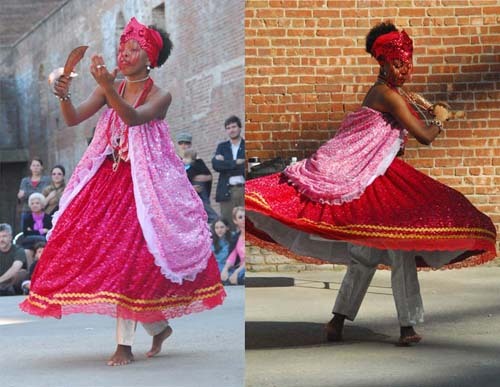Con Edison Immigrant Artist Program Newsletter, Issue No. 19
Featured Artist: Rita Silva
(Note: This month, our IAP Intern, Flavia Berindogue — a Brazilian artist and designer — interviews Rita Silva, a Brazilian artist based in New York. The interview was conducted in Portuguese and translated into English. For the English version, please see below. )
Rita Silva é uma dançarina Afro-Brasileira de Salvador, Bahia que vive no Brooklyn desde 1994. É uma artista e professora de dança. Para ela, liberdade está conectada à dança. Entre suas performances estão: danças dos Orixás (Espíritos ou Divindades Africanas) na tradição do Candomblé; solo improvisações para Oshun e Oyá; solo a cappela; samba de roda; danças caboclas; além de cantar e tocar instrumentos para capoeira. Como professora de dança Rita participou do Folk Feet Program no Brooklyn Arts Council (BAC) e conduziu varios workshops de dança em escolas primárias e secundárias.
IAP: O Candomblé foi trazido ao Brazil durante a colonização, encarnado no corpo e na fé dos negros africanos. Cultuado através das baladas e cantos, era uma forma dos escravos extravazarem com as adversidades da escravidão e de recuperarem suas referências africanas. Ainda hoje, é uma cultura forte e presente nas artes brasileiras, notadamente no samba, e um dos simbolos do Nordeste Brasileiro. Como o Candomblé veio fazer parte da sua vida?
RS: Através da minha Tia Isaura que era filha de Santo do Candomblé.
IAP: Orixás significam “Espírito de Luz” e são considerados divindades do Candomblé, que representa os elementos da natureza. Quais as divindades que você representa através da dança?
RS: Iansã (Yansa), dona dos ventos e das tempestades; e Oxum, Mãe das águas doces e da beleza.
IAP: Os movimentos na dança são intensos, nos reportam aos rituais tribais. Ao mesmo tempo são muito sensuais. O corpo parece não ser apenas usado para uma expressão visual, mas parece assumir o papel de um texto, que através dos gestos narra histórias de um determinado grupo social. Qual a importância e o significado dos gestos na dança aos Orixás?
RS: Para mim os gestos da dança aos Orixás significam e representam a força e os elementos da natureza em sua forma de expressão.
IAP: Você está divulgando o folklore brasileiro para uma geração onde o consumo e a tecnologia fazem parte do dia a dia deles. Como é pensar o Candomblé, uma religião extremamente voltada à natureza, com a Modernidade? Quais são os desafios para você como professora em repassar aos seus alunos sua crença naturalistica?
RS: Eu não uso da crença do Candomblé para ensinar a dança do folclore brasileiro. Eu me expresso com todo respeito à natureza como qualquer ser humano que vive e está conectado nessa planeta Terra. No meu entendimento sobre natureza é que se não tentarmos entender que estamos vivos por que a mãe natureza existe, dentro de todos nós estaremos completamente perdidos nesse planeta. Por exemplo, se ficarmos sem beber água ou se não tivermos oxigênio para respirar, não existirá vida no corpo humano. Essa é a maneira que eu me expresso quando eu passo minha mensagem através da dança.
IAP: O Brazil é um país rico nas artes folclóricas, mas que pouco valoriza suas tradições. Assim como outras expressões folclóricas, o Candomblé não é incluído na educação como sendo uma importante referência para a cultura brasileira. Basicamente, está concentrado no estado da Bahia. Você acredita que fora do Brazil seu trabalho ganha mais reconhecimento?
RS: Para mim foi diferente. Eu sempre fui reconhecida com a minha dança folclórica no Brasil (gracas a Deus), e pela Professora Emilia Biancardi Ferreira. No Colégio Severino Vieira conheci a fundadora e diretora do grupo folclórico Viva Bahia. Fazendo parte do grupo como dançarina, tive a oportunidade de viajar por muitas cidades do Brasil, da América Latina, Europa e Estados Unidos, bem antes de vir viver fora do nosso país. No Brasil, fundei meu próprio grupo folclórico chamado Bahia Magia que sobreviveu por mais de nove anos. Viajamos muito com o departamento de Turismo da Bahia (Bahiatursa) representando o folclore da Bahia. Assim, tive a sorte de viver a minha arte e ser reconhecida em nossa terra muito antes de vir aos Estados Unidos.
IAP: Onde podemos assistir à sua performance?
RS: Nesse momento nao tenho show previsto para esse final de ano. O nosso primero show está previsto para Fevereiro de 2011.
English Translation
This month, our IAP Intern Flavia Berindogue, a Brazilian artist and designer, interviews Rita Silva, a Brazilian artist based in New York.
Silva is an Afro-Brazilian dancer from Salvador, Bahia and has been living in Brooklyn since 1994. She is a working and teaching artist. To her, freedom is attached to dance. She performs the following: dances for the orixá (African spirit or deity) in the candomblétradition; solo improvisations for Oshun and Oya; solo a cappela; samba de roda; caboclodances; as well as singing and playing instruments for capoeira. She was part of the Brooklyn Arts Council (BAC) Folk Feet Program as a teaching artist and held many dance workshops at elementary and high schools throughout Brooklyn.
IAP: The Candomblé was brought to Brazil during its period of colonization, incarnated in the body and faith of the Africans who were brought to the country by force. Worshipped through dance and song as a form to overcome the adversity of slavery and reclaim Africans references, it is still a strong culture, influencing Brazilian art forms such as the samba. How did the Candomblé become part of your life?
RS: I began through my aunt Isaura who was a Saint’s daughter of Candomblé.
IAP: Orixás mean “Spirits of Light” and are considered deities of Candomblé representing the elements of nature. What deity do you represent in your dance?
RS: I dress for the divinity Iansã (Yansa) who represents winds and storms; and Oxum, mother of sweet waters and beauty.
IAP: The movements of the dance are very intense, at times reminiscent of tribal rituals, but at the same time very sensual. The body does not only express a visual action, but it seems to assume the paper of a text, where through the gestures it tells stories of a social group. What is the importance and significance of the gestures in the dance?
RS: For me the gestures of the dance for Orixás represent the power and the elements of nature in its expression and form.
IAP: You are spreading Brazilian folk arts to a generation in which consumption and technology are part of everyday life. What are the challenges for you as a teacher passing your beliefs about nature through forms such as Candomblé to your students?
RS: I don’t use the belief of the Candomblé to teach the dance of the Brazilian folklore. I totally express with a respect for nature as any human being that lives and is connected with the Earth. In my thoughts on nature, if you don’t understand that we are livings creatures due to the fact that Mother Nature exists, then we will be completely lost in this planet. For example, if there is no water or oxygen, there will be no life in the human body. This is the way I express and this is the message I try to pass through the dance.
IAP: Brazil is rich in folk arts, but the country does not give a real value to these traditions. As with many other folk arts, Candomblé is not included in school education as an important part of the Brazilian culture. This tradition is basically concentrated in Bahia state. How were you able to receive recognition for your work?
RS: I had a different experience. I was always recognized as a dancer of Brazilian folk arts in Brazil, and also recognized by the prominent teacher Emilia Biancardi Ferreira. At Severino Vieira School, I met the founder and director of the national folk group Viva Bahia. I became part of this group as a dancer and I had the opportunity to travel with Viva Bahia to many cities in Brazil and other parts of South America as well as Europe and the United States before I left my home country. In Brazil, I established a folk group called “Bahia Magia” that survived nine years. We traveled to many places with the Bahia Tourism Department (Bahiatursa) representing the Bahian folk arts. Thus, I had the luck to show my art and be recognized in Brazil before I came to the United States to live.
IAP: Where can we see your performance?
RS: At this moment I do not have show foreseen for this end of year. Our upcoming show will be in February 2011. You can contact me at [email protected].





